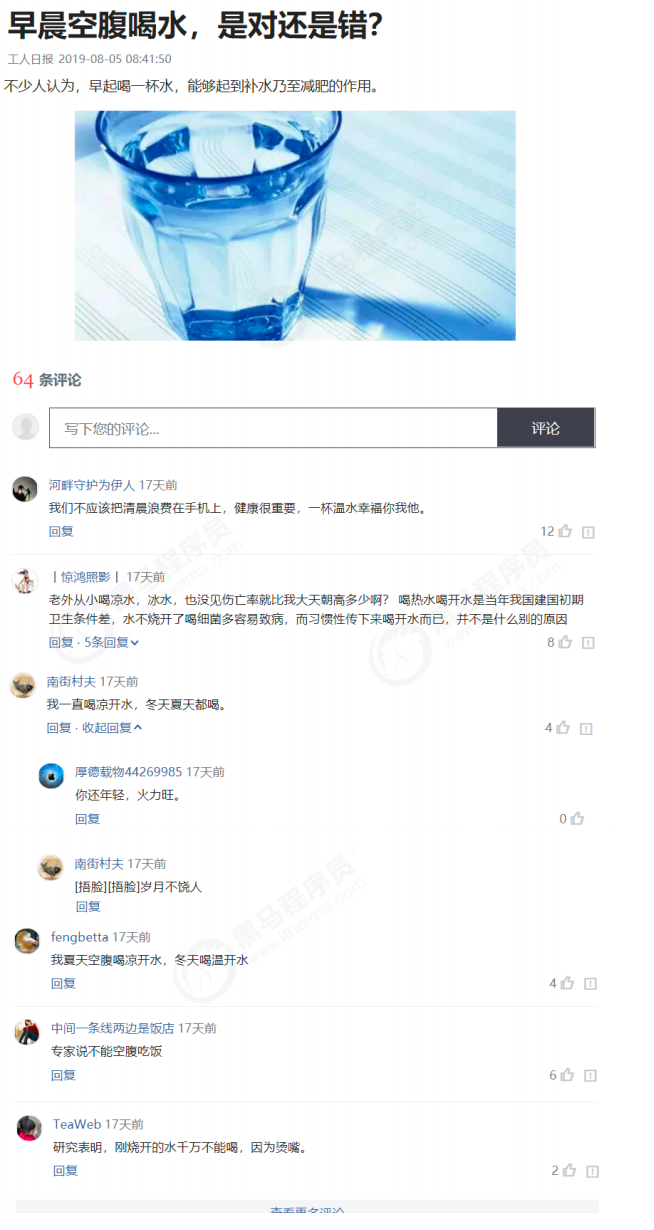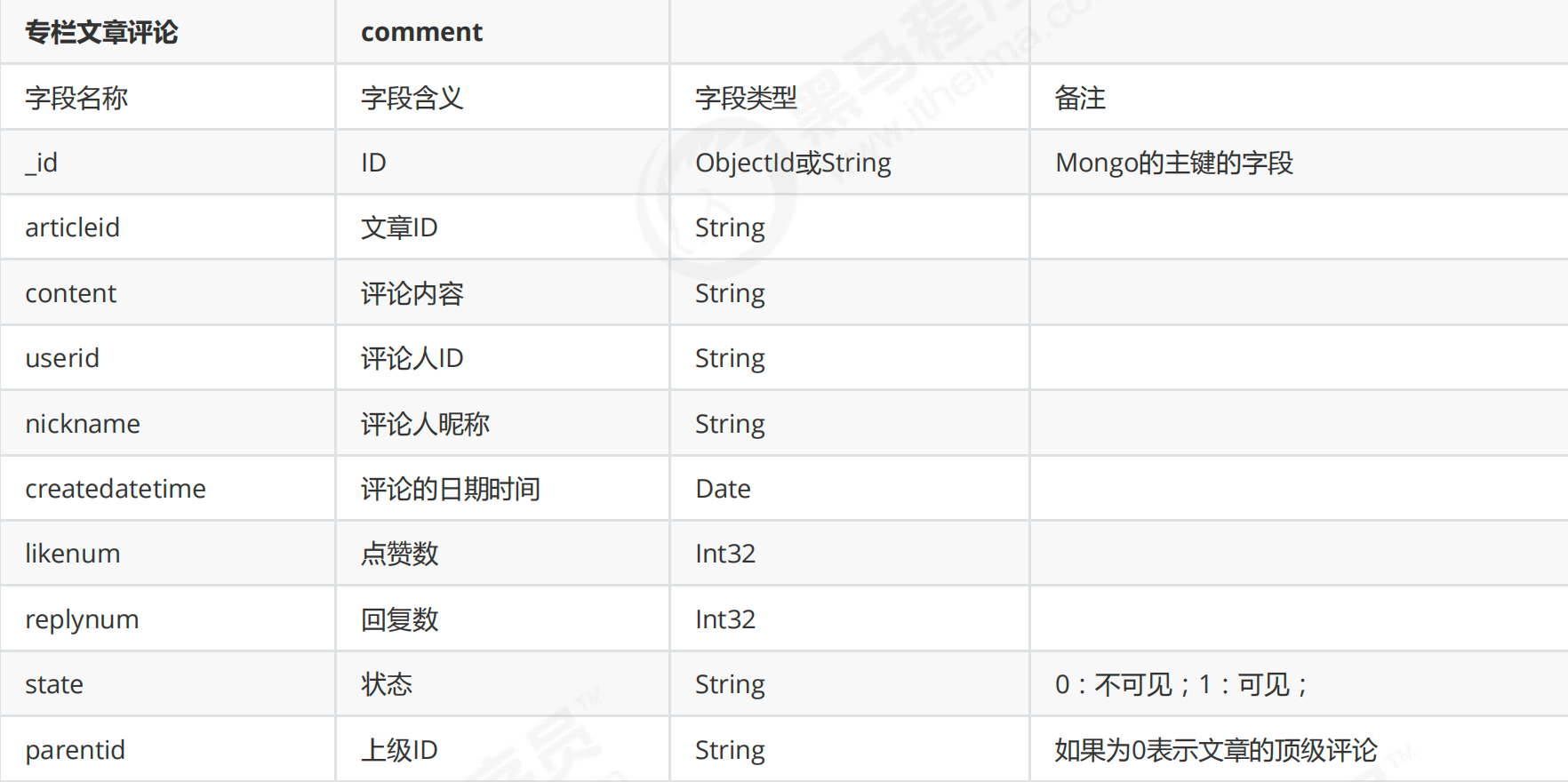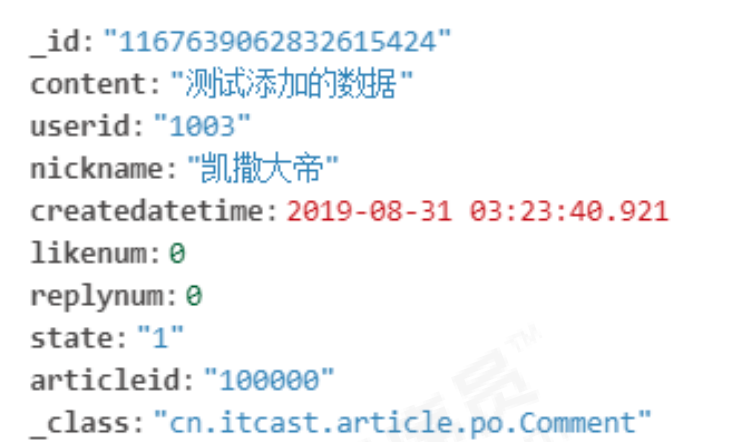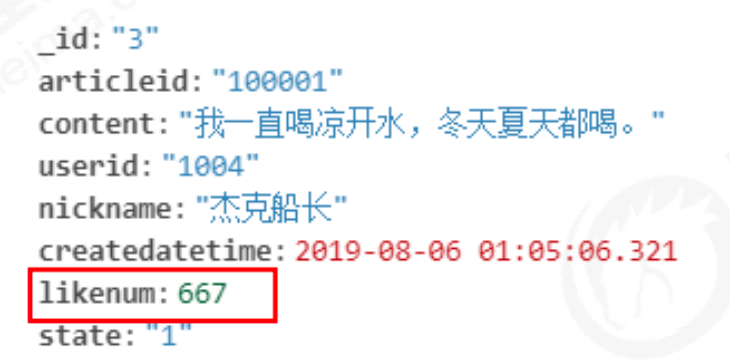一、文章评论
(一) 需求分析
某头条的文章评论业务如下:

文章示例参考:早晨空腹喝水,是对还是错?https://www.toutiao.com/a6721476546088927748/
需要实现以下功能:
1)基本增删改查API
2)根据文章id查询评论
3)评论点赞
(二) 表结构分析
数据库:articledb

(三) 技术选型
1. MongoDBDriver
mongodb-driver是mongo官方推出的java连接mongoDB的驱动包,相当于JDBC驱动。我们通过一个入门的案例来了解mongodb-driver的基本使用。
官方驱动说明和下载:MongoDB Java Drivers
官方驱动示例文档:Quick Start
2. SpringDataMongoDB
SpringData家族成员之一,用于操作MongoDB的持久层框架,封装了底层的mongodb-driver。
官网主页: Spring Data MongoDB
我们十次方项目的吐槽微服务就采用SpringDataMongoDB框架。
(四) 文章微服务模块
(1)搭建项目工程article,pom.xml引入依赖:
<?xml version="1.0" encoding="UTF-8"?>
<project xmlns="http://maven.apache.org/POM/4.0.0"
xmlns:xsi="http://www.w3.org/2001/XMLSchema-instance"
xsi:schemaLocation="http://maven.apache.org/POM/4.0.0 http://maven.apache.org/xsd/maven-4.0.0.xsd">
<modelVersion>4.0.0</modelVersion>
<parent>
<groupId>org.springframework.boot</groupId>
<artifactId>spring-boot-starter-parent</artifactId>
<version>2.1.6.RELEASE</version>
<relativePath/> <!-- lookup parent from repository -->
</parent>
<groupId>cn.itcast</groupId>
<artifactId>article</artifactId>
<version>1.0-SNAPSHOT</version>
<dependencies>
<dependency>
<groupId>org.springframework.boot</groupId>
<artifactId>spring-boot-starter-test</artifactId>
<scope>test</scope>
</dependency>
<dependency>
<groupId>org.springframework.boot</groupId>
<artifactId>spring-boot-starter-data-mongodb</artifactId>
</dependency>
</dependencies>
</project>(2)创建application.yml
spring:
#数据源配置
data:
mongodb:
# 主机地址
host: 192.168.40.141
# 数据库
database: articledb
# 默认端口是27017
port: 27017
#也可以使用uri连接
#uri: mongodb://192.168.40.134:27017/articledb(3)创建启动类
@SpringBootApplication
public class ArticleApplication {
public static void main(String[] args) {
SpringApplication.run(ArticleApplication.class, args);
}
}(4)启动项目,看是否能正常启动,控制台没有错误。
(五) 文章评论实体
创建实体类 包下建包po用于存放实体类,创建实体类
/**
* 文章评论实体类
*/
//把一个java类声明为mongodb的文档,可以通过collection参数指定这个类对应的文档。
//@Document(collection="mongodb 对应 collection 名")
// 若未加 @Document ,该 bean save 到 mongo 的 comment collection
// 若添加 @Document ,则 save 到 comment collection
@Document(collection="comment")//可以省略,如果省略,则默认使用类名小写映射集合
//复合索引
// @CompoundIndex( def = "{'userid': 1, 'nickname': -1}")
public class Comment implements Serializable {
//主键标识,该属性的值会自动对应mongodb的主键字段"_id",如果该属性名就叫“id”,则该注解可以省略,否则必须写
@Id
private String id;//主键
//该属性对应mongodb的字段的名字,如果一致,则无需该注解
@Field("content")
private String content;//吐槽内容
private Date publishtime;//发布日期
//添加了一个单字段的索引
@Indexed
private String userid;//发布人ID
private String nickname;//昵称
private LocalDateTime createdatetime;//评论的日期时间
private Integer likenum;//点赞数
private Integer replynum;//回复数
private String state;//状态
private String parentid;//上级ID
private String articleid;
//getter and setter.....
public String getId() {
return id;
}
public void setId(String id) {
this.id = id;
}
public String getContent() {
return content;
}
public void setContent(String content) {
this.content = content;
}
public Date getPublishtime() {
return publishtime;
}
public void setPublishtime(Date publishtime) {
this.publishtime = publishtime;
}
public String getUserid() {
return userid;
}
public void setUserid(String userid) {
this.userid = userid;
}
public String getNickname() {
return nickname;
}
public void setNickname(String nickname) {
this.nickname = nickname;
}
public LocalDateTime getCreatedatetime() {
return createdatetime;
}
public void setCreatedatetime(LocalDateTime createdatetime) {
this.createdatetime = createdatetime;
}
public Integer getLikenum() {
return likenum;
}
public void setLikenum(Integer likenum) {
this.likenum = likenum;
}
public Integer getReplynum() {
return replynum;
}
public void setReplynum(Integer replynum) {
this.replynum = replynum;
}
public String getState() {
return state;
}
public void setState(String state) {
this.state = state;
}
public String getParentid() {
return parentid;
}
public void setParentid(String parentid) {
this.parentid = parentid;
}
public String getArticleid() {
return articleid;
}
public void setArticleid(String articleid) {
this.articleid = articleid;
}
@Override
public String toString() {
return "Comment{" +
"id='" + id + '\'' +
", content='" + content + '\'' +
", publishtime=" + publishtime +
", userid='" + userid + '\'' +
", nickname='" + nickname + '\'' +
", createdatetime=" + createdatetime +
", likenum=" + likenum +
", replynum=" + replynum +
", state='" + state + '\'' +
", parentid='" + parentid + '\'' +
", articleid='" + articleid + '\'' +
'}';
}
}说明:索引可以大大提升查询效率,一般在查询字段上添加索引,索引的添加可以通过Mongo的命令来添加,也可以在Java的实体类中通过注解添加。
1)单字段索引注解@Indexed
org.springframework.data.mongodb.core.index.Indexed.class,声明该字段需要索引,建索引可以大大的提高查询效率。
db.comment.createIndex({"userid":1})2)复合索引注解@CompoundIndex
org.springframework.data.mongodb.core.index.CompoundIndex.class,复合索引的声明,建复合索引可以有效地提高多字段的查询效率。
db.comment.createIndex({"userid":1,"nickname":-1})(六) 文章评论基本增删改查
(1)创建数据访问接口 创建dao包,包下创建接口
//评论的持久层接口
public interface CommentRepository extends MongoRepository<Comment,String> {
}(2)创建业务逻辑类创建service包,包下创建类
//评论的业务层
@Service
public class CommentService {
//注入dao
@Autowired
private CommentRepository commentRepository;
/**
* 保存一个评论
* @param comment
*/
public void saveComment(Comment comment){
//如果需要自定义主键,可以在这里指定主键;如果不指定主键,MongoDB会自动生成主键
//设置一些默认初始值。。。
//调用dao
commentRepository.save(comment);
}
/**
* 更新评论
* @param comment
*/
public void updateComment(Comment comment){
//调用dao
commentRepository.save(comment);
}
/**
* 根据id删除评论
* @param id
*/
public void deleteCommentById(String id){
//调用dao
commentRepository.deleteById(id);
}
/**
* 查询所有评论
* @return
*/
public List<Comment> findCommentList(){
//调用dao
return commentRepository.findAll();
}
/**
* 根据id查询评论
* @param id
* @return
*/
public Comment findCommentById(String id){
//调用dao
return commentRepository.findById(id).get();
}
}(3)新建Junit测试类,测试保存和查询所有:
//测试评论的业务层
//SpringBoot的Junit集成测试
@RunWith(SpringRunner.class)
//SpringBoot的测试环境初始化,参数:启动类
@SpringBootTest(classes = ArticleApplication.class)
public class CommentServiceTest {
//注入Service
@Autowired
private CommentService commentService;
/**
* 保存一个评论
*/
@Test
public void testSaveComment(){
Comment comment=new Comment();
comment.setArticleid("100000");
comment.setContent("测试添加的数据");
comment.setCreatedatetime(LocalDateTime.now());
comment.setUserid("1003");
comment.setNickname("凯撒大帝");
comment.setState("1");
comment.setLikenum(0);
comment.setReplynum(0);
commentService.saveComment(comment);
}
/**
* 查询所有数据
*/
@Test
public void testFindAll(){
List<Comment> list = commentService.findCommentList();
System.out.println(list);
}
/**
* 测试根据id查询
*/
@Test
public void testFindCommentById(){
Comment comment = commentService.findCommentById("5d6a27b81b8d374798cf0b41");
System.out.println(comment);
}
}添加结果:

(七) 根据上级ID查询文章评论分页列表
(1)CommentRepository新增方法定义
//根据父id,查询子评论的分页列表
Page<Comment> findByParentid(String parentid, Pageable pageable);(2)CommentService新增方法
/**
* 根据父id查询分页列表
* @param parentid
* @param page
* @param size
* @return
*/
public Page<Comment> findCommentListPageByParentid(String parentid,int page ,int size){
return commentRepository.findByParentid(parentid, PageRequest.of(page-1,size));
}(3)junit测试用例:
/**
* 测试根据父id查询子评论的分页列表
*/
@Test
public void testFindCommentListPageByParentid(){
Page<Comment> pageResponse = commentService.findCommentListPageByParentid("3", 1, 2);
System.out.println("----总记录数:"+pageResponse.getTotalElements());
System.out.println("----当前页数据:"+pageResponse.getContent());
}(4)测试
使用compass快速插入一条测试数据,数据的内容是对3号评论内容进行评论。

执行测试,结果:
----总记录数:1
----当前页数据:[Comment{id='33', content='你年轻,火力大', publishtime=null, userid='1003', nickname='凯撒大帝',
createdatetime=null, likenum=null, replynum=null, state='null', parentid='3', articleid='100001'}](八) MongoTemplate实现评论点赞
我们看一下以下点赞的临时示例代码: CommentService 新增updateThumbup方法
/**
* 点赞-效率低
* @param id
*/
public void updateCommentThumbupToIncrementingOld(String id){
Comment comment = CommentRepository.findById(id).get();
comment.setLikenum(comment.getLikenum()+1);
CommentRepository.save(comment);
}以上方法虽然实现起来比较简单,但是执行效率并不高,因为我只需要将点赞数加1就可以了,没必要查询出所有字段修改后再更新所有字段。(蝴蝶效应)
我们可以使用MongoTemplate类来实现对某列的操作。
(1)修改CommentService
//注入MongoTemplate
@Autowired
private MongoTemplate mongoTemplate;
/**
* 点赞数+1
* @param id
*/
public void updateCommentLikenum(String id){
//查询对象
Query query=Query.query(Criteria.where("_id").is(id));
//更新对象
Update update=new Update();
//局部更新,相当于$set
// update.set(key,value)
//递增$inc
// update.inc("likenum",1);
update.inc("likenum");
//参数1:查询对象
//参数2:更新对象
//参数3:集合的名字或实体类的类型Comment.class
mongoTemplate.updateFirst(query,update,"comment");
}(2)测试用例:
/**
* 点赞数+1
*/
@Test
public void testUpdateCommentLikenum(){
//对3号文档的点赞数+1
commentService.updateCommentLikenum("3");
}执行测试用例后,发现点赞数+1了:























 253
253

 被折叠的 条评论
为什么被折叠?
被折叠的 条评论
为什么被折叠?








